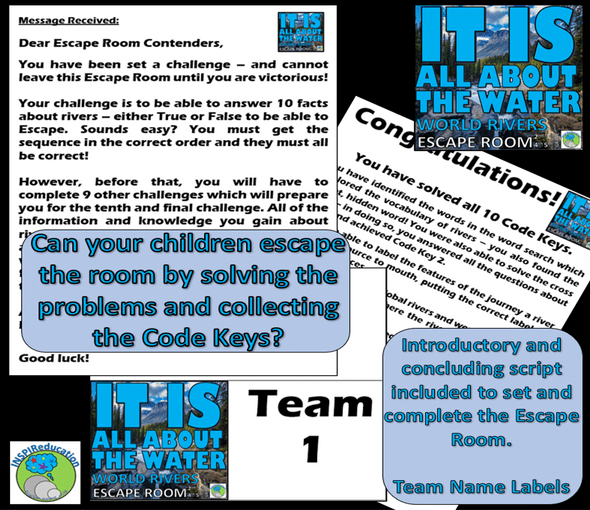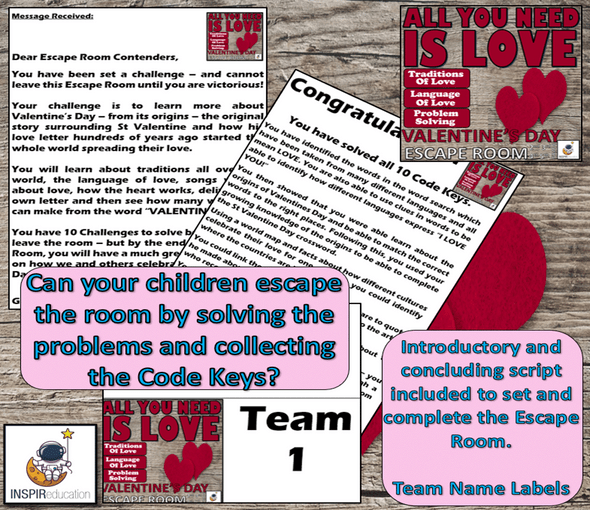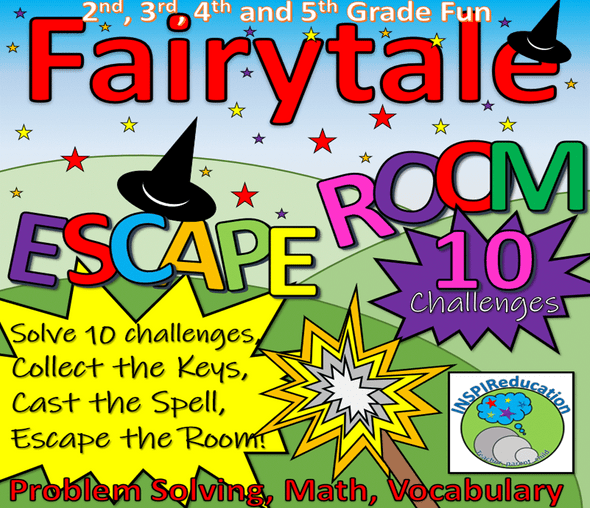Description
Using an Escape Room to develop curriculum knowledge is an exciting activity that will inspire learners from 2nd Grade to 5th Grade.
The curriculum content of this Escape Room is linked to Geography, and in particular:
- To know the language and meaning of the key vocabulary associated with the Water Cycle
- Be able to label the Water Cycle in the environment using a scientific diagram
- To name the key features and processes within the water cycle
- Identify condensation, precipitation, transpiration and evaporation in real life contexts beyond weather features
- To know where deserts are in the world and understand why their position is influential to their status
- To know the names and definitions of different bodies of water and that run off and infiltration can create these.
The aim of the Escape Room is to provide jeopardy for the children to work under pressure to solve 10 clues to help raise their knowledge of The Water Cycle. The 10 Challenges within this Escape Room will support knowledge and understanding of the Water Cycle and how it impacts on our daily lives with real-life scenarios which students can explore.
Included within this Escape Room:
- Pupil Answer Book (Code Key Booklet)
- Answer Booklet for teachers
- Starting script to set the scene of the Escape Room and explain what the students must do
- Concluding script, celebrating the learning which has taken place and allows the students to “leave” the Escape Room
- Table labels for students to name their own teams
- Full instructions to be able to simply print and go within your own classroom
Before beginning, you will need to prepare the following:
- A copy of the Pupil Workbook for each group
- A set of table team names for every group – prepared beforehand and given to each group to set up their own working space
- IT sources and research materials
- Initial Starting Script sharing the problem to the children
- Completion Script celebrating the completion of the challenge
Children do not need prior knowledge of the Water Cycle to complete this Escape Room so is suitable for a starter challenge to a new topic. The ability to have access to research resources will support the answers. This Escape Room is ideal as a review of learning to identify what the children have learnt and retained as a result of completing the study unit of the Water Cycle.
The activity begins by the teacher reader the Initial Message received. It clearly tells the children that they are required to help raise their understanding of the Water Cycle in order to answer 10 True of False questions in the correct sequence in order to escape the room. The accurate completion of each of the challenges enables the students to move from one challenge to another. They must complete each challenge correctly before moving onto the next challenge, continuing the Escape Room collecting all ten!
After the 10th activity – the teacher can read the final script which reviews the learning the children have undertaken as they have completed each of the challenges. This script, together with team labels and the opening challenge script are contained within the Resource Pack.
Each activity focuses and builds the children’s knowledge of The Water Cycle.
The 10 activities are based on the following outcomes:
- Word Search to introduce 25 key words related to the Water Cycle ensuring that children develop a wide vocabulary. There is also an extra hidden word which the children must find in order to solve the Code Key and move to the next challenge.
- Crossword to complete which introduces further important information to the children – there are 13 clues to solve.
- Linking scientific vocabulary to their definitions – 5 words integral to the Water Cycle
- Labelling a scientific diagram of a cross section of the Earth – adding on 6 key terms within the water cycle – in action in the diagram.
- Linking the names and global continent position of 12 deserts in the world, and explaining how their position in the world impacts on their geographical features.
- The Water Cycle – Cloze Procedure – add the missing words to make the text make sense – the processes in the Water Cycle
- Where in the World? Identifying the position of 12 major deserts in the world and explaining how their position influences their conditions (equatorial links)
- What will happen next – predicting the processes which will occur in real-life scenarios and why.
- Vocabulary of water bodies and their definitions (ocean, sea, river, lake, stream, pond, rockpool, swamp)
- Real life processes – given 14 scenarios, students to select the processes involved within the water cycle from evaporation, condensation, transpiration, infiltration or precipitation – or a mixture of more than one!
- True or False – final challenge using the knowledge gained within this Escape Room – 10 statements.
When all 10 activities are completed, and the children have gained the correct Code Keys from each activity, the final celebratory script can be read which reviews the learning and informs the children that they have been successful and can leave the Escape Room!
Setting up the Escape Room
1. Children should be split into groups of no more than four and be placed in their own workspace.
2. Access to IT and research materials should be provided to allow children to research answers to questions and review their own knowledge, as well as checking answers.
3. Each group should have a Code Key Booklet and decide on a team name
4. Read the Initial Message to the children to set the challenge in context. Discuss what this means, and what the activity entails.
5. Turn to Code Key 1. Agree with the children a set time to complete the problem in – this ensures that the children stay on task and maintains the Escape Room element of working under pressure.
6. At the end of the time, children should have filled in the Code Key in their booklet. The teacher can then check the accuracy of all the groups and talk through the responses the children should have.
7. Move on through the remaining challenges until all 10 have been completed.
8. For those groups who have been successful, they are then able to read the completed statement where they find out if they have escaped the Escape Room!
There are other ways of running Escape Room activities, for example, each activity could be set up on 10 tables and the children then move from table to table completing the activity. This would reduce the need for as many resources, and access to non-fiction sources and Internet Resources could then be targeted at specific Challenges.
The Escape Room should last for at least 2 hours.
We hope that your children enjoy this Escape Room.






























